- Home
- About Us
- Industry
- Services
- Reading
- Contact Us
Automotive Cabin Air Quality Sensors Market : Current Analysis and Forecast (2024-2032)
Emphasis on Type (Pressure Sensors, and Temperature Sensors), Technology Type (Active Sensors, Passive Sensors), Vehicle Type (Passenger Vehicle and Commercial Vehicle), and Region/Country.
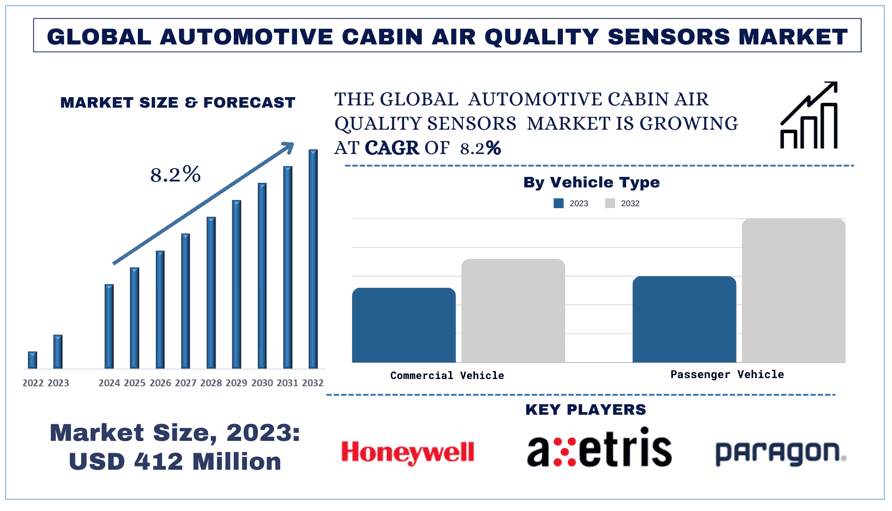
Automotive Cabin Air Quality Sensors Market Size & Forecast
The automotive cabin air quality sensors market was valued at USD 412 Million in 2023 and is expected to grow at a robust CAGR of around 8.2 % during the forecast period (2024-2032).
Automotive Cabin Air Quality Sensors Market Analysis
The automotive industry has witnessed a significant shift towards prioritizing passenger health and well-being, particularly in the wake of growing concerns about air pollution and its impact on human health. As a result, the demand for automotive cabin air quality sensors has been on the rise, driven by the need to ensure a healthier and more comfortable in-car experience. As the automotive cabin air quality sensors market continues to evolve, we can expect to see a wave of innovative solutions that push the boundaries of in-vehicle air quality management.
Automotive Cabin Air Quality Sensors Market Trends
The global automotive cabin air quality sensors market is witnessing unprecedented growth, driven by the increasing demand for luxury and premium vehicles and increasing awareness of health and safety.
One emerging trend is the integration of artificial intelligence (AI) and machine learning (ML) technologies, which can enable cabin air quality sensors to adapt and respond to changing environmental conditions in real time. By leveraging these advanced analytical capabilities, automakers can create truly intelligent air quality systems that optimize the cabin environment based on the specific needs of the occupants.
Another exciting development is the convergence of cabin air quality sensors with other in-vehicle technologies, such as advanced climate control systems and air filtration solutions. By seamlessly integrating these complementary systems, automakers can create a comprehensive and highly effective approach to maintaining clean, healthy, and comfortable cabin air.
As the automotive industry continues to adapt to the growing demands for sustainable and wellness-focused transportation, the cabin air quality sensors market will undoubtedly play a pivotal role in shaping the future of in-vehicle experiences. From improved respiratory health to enhanced passenger comfort, the advancements in this market have the potential to transform the way we think about and interact with our automobiles.
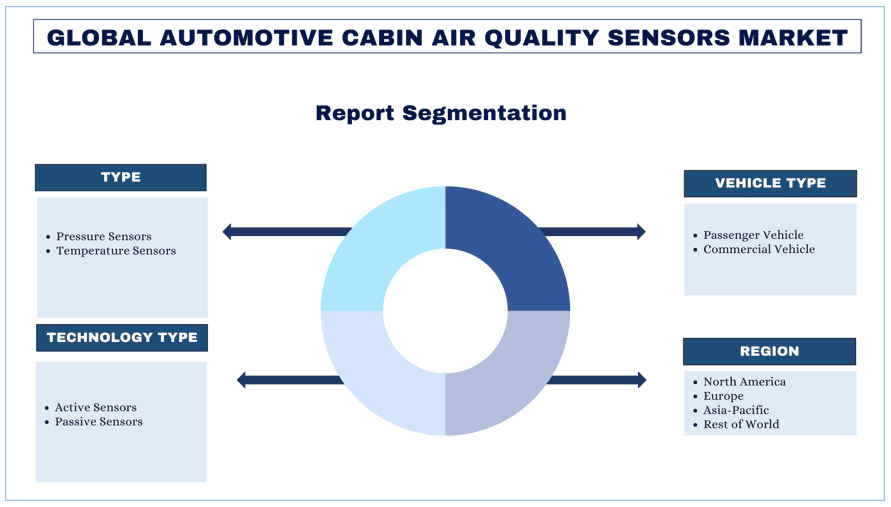
Asia Pacific is expected to Grow with a Significant CAGR During the Forecast Period.
The Asia Pacific region is experiencing continuous growth in the automotive industry and the technologically advanced components and features in vehicles are in demand in this region. Consumers are now willing to spend more due to an increment in their disposable income and increasing awareness about health is leading to the tremendous growth of the luxury and premium segment of the vehicle in the market. Luxury and Premium vehicles are equipped with cabin air quality sensors, so growth of this segment is boosting the Automotive Cabin Air Quality Sensors market rapidly in this region. It is forecasted to hold a dominating growth in upcoming years.
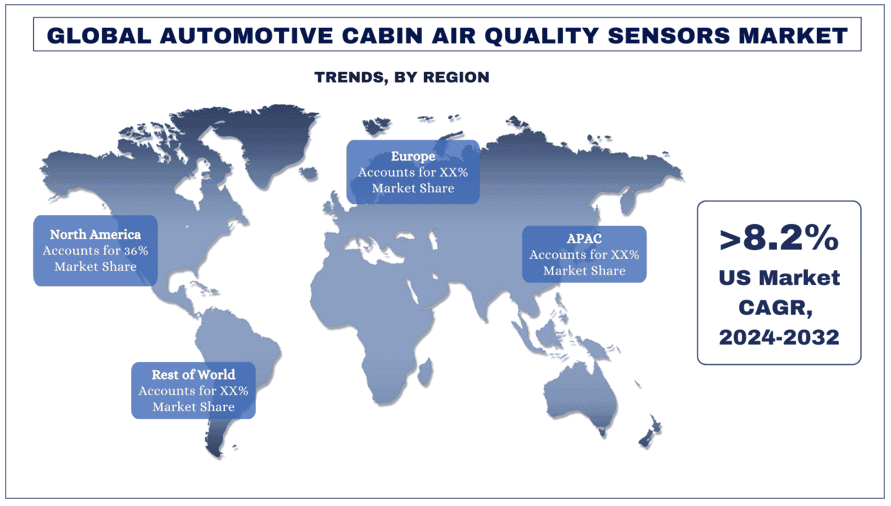
Automotive Cabin Air Quality Sensors Industry Overview
The automotive cabin air quality sensors market is competitive and fragmented, with several global and international market players. The key players are adopting different growth strategies to enhance their market presence, such as partnerships, agreements, collaborations, new product launches, geographical expansions, and mergers and acquisitions. Some of the major players operating in the market are Honeywell International Inc., Axetris AG, Paragon AG, Sensata Technologies Inc., OMRON Corporation, Amphenol Corporation., UST Umweltsensortechnik GmbH, Hanon Systems, Sensirion AG, and Prodrive Technologies B.V.
Automotive Cabin Air Quality Sensors Market News
In June 2023, Sensirion announced the integration of its air quality sensors with the RESET Air Standard. This integration aims to streamline the accreditation procedure for indoor air quality monitors. Customers can now adhere to RESET standards effortlessly. This development ensures precise and dependable monitoring of indoor air quality.
In June 2021, Prodrive Technologies developed a sensor to measure dust particles. It can evaluate dust particles both inside and outside of a car. Car manufacturers can utilize this data to improve the air quality within the vehicle.
Automotive Cabin Air Quality Sensors Market Report Coverage
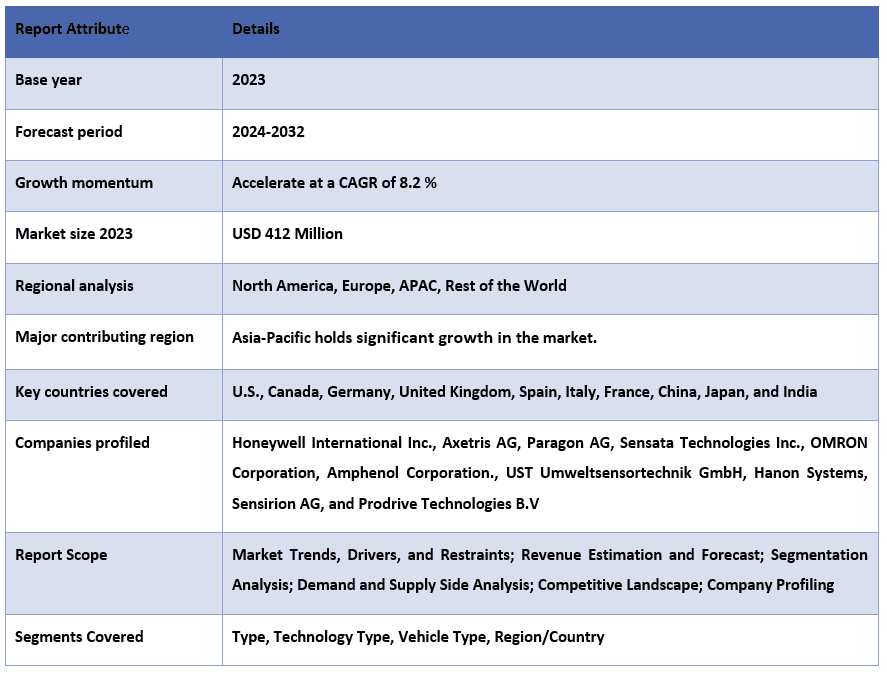
Reasons to buy this report:
- The study includes market sizing and forecasting analysis validated by authenticated key industry experts.
- The report briefly reviews overall industry performance at one glance.
- The report covers an in-depth analysis of prominent industry peers with a primary focus on key business financials, product portfolios, expansion strategies, and recent developments.
- Detailed examination of drivers, restraints, key trends, and opportunities prevailing in the industry.
- The study comprehensively covers the market across different segments.
- Deep dive regional level analysis of the industry.
Customization Options:
The global automotive cabin air quality sensors market can further be customized as per the requirement or any other market segment. Besides this, UMI understands that you may have your own business needs, hence feel free to connect with us to get a report that completely suits your requirements.
Table of Content
Research Methodology for the Automotive Cabin Air Quality Sensors Market Analysis (2024-2032)
Analyzing the historical market, estimating the current market, and forecasting the future market of the global automotive cabin air quality sensors market were the three major steps undertaken to create and analyze the adoption of automotive cabin air quality sensors in major regions globally. Exhaustive secondary research was conducted to collect the historical market numbers and estimate the current market size. Secondly, to validate these insights, numerous findings and assumptions were taken into consideration. Moreover, exhaustive primary interviews were also conducted, with industry experts across the value chain of the global automotive cabin air quality sensors market. Post assumption and validation of market numbers through primary interviews, we employed a top-down/bottom-up approach to forecasting the complete market size. Thereafter, market breakdown and data triangulation methods were adopted to estimate and analyze the market size of segments and sub-segments of the industry. Detailed methodology is explained below:
Analysis of Historical Market Size
Step 1: In-Depth Study of Secondary Sources:
A detailed secondary study was conducted to obtain the historical market size of the automotive cabin air quality sensors market through company internal sources such as annual reports and financial statements, performance presentations, press releases, etc., and external sources including journals, news and articles, government publications, competitor publications, sector reports, third-party databases, and other credible publications.
Step 2: Market Segmentation:
After obtaining the historical market size of the automotive cabin air quality sensors market, we conducted a detailed secondary analysis to gather historical market insights and share for different segments & sub-segments for major regions. Major segments are included in the report as type, technology type, and vehicle type. Further country-level analyses were conducted to evaluate the overall adoption of testing models in that region.
Step 3: Factor Analysis:
After acquiring the historical market size of different segments and sub-segments, we conducted a detailed factor analysis to estimate the current market size of the automotive cabin air quality sensors market. Further, we conducted factor analysis using dependent and independent variables such as type, technology type, and vehicle type of the automotive cabin air quality sensors market. A thorough analysis was conducted for demand and supply-side scenarios considering top partnerships, mergers and acquisitions, business expansion, and product launches in the global automotive cabin air quality sensors market sector.
Current Market Size Estimate & Forecast
Current Market Sizing: Based on actionable insights from the above 3 steps, we arrived at the current market size, key players in the global automotive cabin air quality sensors market, and market shares of the segments. All the required percentage shares split, and market breakdowns were determined using the above-mentioned secondary approach and were verified through primary interviews.
Estimation & Forecasting: For market estimation and forecast, weights were assigned to different factors including drivers & trends, restraints, and opportunities available for the stakeholders. After analyzing these factors, relevant forecasting techniques i.e., the top-down/bottom-up approach were applied to arrive at the market forecast for 2032 for different segments and sub-segments across the major markets globally. The research methodology adopted to estimate the market size encompasses:
- The industry’s market size, in terms of revenue (USD) and the adoption rate of the automotive cabin air quality sensors market across the major markets domestically.
- All percentage shares, splits, and breakdowns of market segments and sub-segments
- Key players in the global automotive cabin air quality sensors market in terms of products offered. Also, the growth strategies adopted by these players to compete in the fast-growing market.
Market Size and Share Validation
Primary Research: In-depth interviews were conducted with the Key Opinion Leaders (KOLs) including Top Level Executives (CXO/VPs, Sales Head, Marketing Head, Operational Head, Regional Head, Country Head, etc.) across major regions. Primary research findings were then summarized, and statistical analysis was performed to prove the stated hypothesis. Inputs from primary research were consolidated with secondary findings, hence turning information into actionable insights.
Split of Primary Participants in Different Regions
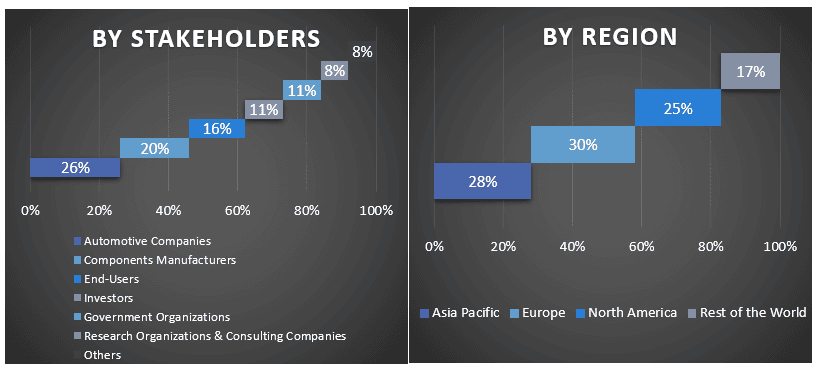
Market Engineering
The data triangulation technique was employed to complete the overall market estimation and to arrive at precise statistical numbers for each segment and sub-segment of the global automotive cabin air quality sensors market. Data was split into several segments & sub-segments after studying various parameters and trends in the type, technology type, and vehicle type of the global automotive cabin air quality sensors market.
The main objective of the Global Automotive Cabin Air Quality Sensors Market Study
The current & future market trends of the global automotive cabin air quality sensors market were pinpointed in the study. Investors can gain strategic insights to base their discretion for investments on the qualitative and quantitative analysis performed in the study. Current and future market trends determined the market’s overall attractiveness at a regional level, providing a platform for the industrial participant to exploit the untapped market to benefit from a first-mover advantage. Other quantitative goals of the studies include:
- Analyze the current and forecast market size of the automotive cabin air quality sensors market in terms of value (USD) and the current and forecast market size of different segments and sub-segments.
- Segments in the study include areas of type, technology type, and vehicle type.
- Define and analyze the regulatory framework for the automotive cabin air quality sensors
- Analyze the value chain involved with the presence of various intermediaries, along with analyzing customer and competitor behaviors of the industry.
- Analyze the current and forecast market size of the automotive cabin air quality sensors market for the major region.
- Major countries of regions studied in the report include Asia Pacific, Europe, North America, and the Rest of the World
- Company profiles of the automotive cabin air quality sensors market and the growth strategies adopted by the market players to sustain in the fast-growing market.
- Deep dive regional level analysis of the industry.
Frequently Asked Questions FAQs
Q1: What is the automotive cabin air quality sensors market's current market size and growth potential?
Q2: What are the driving factors for the growth of the automotive cabin air quality sensors market?
Q3: Which segment has the largest automotive cabin air quality sensors market share by vehicle type?
Q4: What are the emerging technologies and trends in the automotive cabin air quality sensors market?
Q5: Which region will dominate the automotive cabin air quality sensors market?
Related Reports
Customers who bought this item also bought










